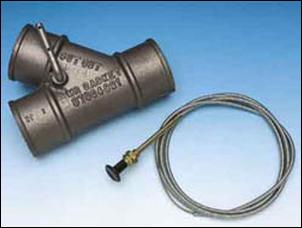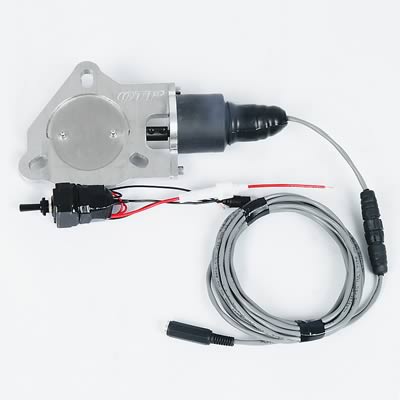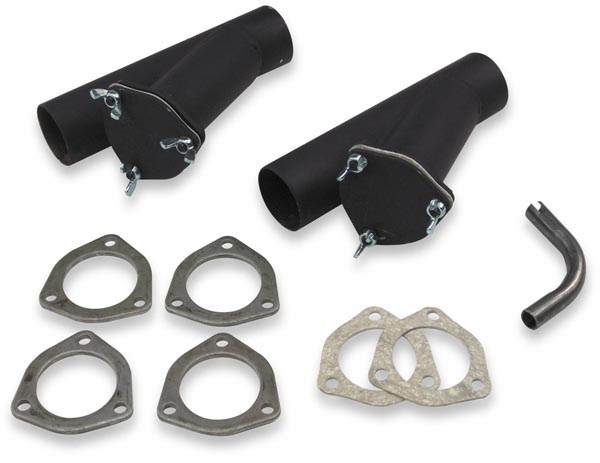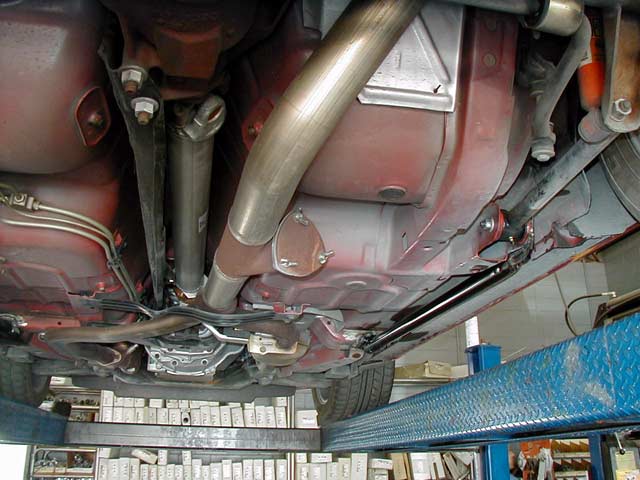| What's Hot! | Products/ Tools | EFI Tuning | Basic Tuning | Advanced Tuning | Chassis Tuning | Advertise with us |
Electronic Exhaust Cutout Basics
An article on the discussion of Cutouts vs. Aftermarket Exhausts
Contributed By: Enginebasics.com


While some of us love the sound of a straight pipe V8, or the high-pitched ring of an Italian motor, there are some of us who just love the bliss of silence. When it comes to exhaust flow, exhaust noise, and power, you will quickly see that they are all linked. You can’t have one without the others being involved in the equation. This causes a problem for some of us that want good exhaust flow and power, but also want the car to be quiet as well.
It’s no surprise that just a straight through exhaust will also be the highest flowing exhaust. There is a reason why we all used to stick toilet paper in our ears at Nascar Races when we were kids. To make a lot of power you need to have a lot of flow, and what comes with a lot of flow, is a lot of noise.
In comes the exhaust cutout. It was a way that automotive enthusiasts could drive their cars daily, or go out for a night on the town with a nice quiet exhaust. Then take that same car to the track and remove the cut-out block plates and open up the exhaust to not only rattle your ear drums out, but make some great power as well. The only problem with this type of cut-out was that one had to manually remove the block off plate. Not only can this be a daunting task based on the cutouts location, but also means that the gain in exhaust flow can’t be called upon whenever the user desires.
How an Exhaust Cutout Works
An Exhaust Cutout is really a Y pipe that is welded into the stock exhaust pipe. One of the Y’s legs continues on the exhaust as normal while the other Y leg can be vented to the atmosphere. Now with the leg vented to the atmosphere the user has control to cap it off leaving the exhaust to flow as the OEM manufacturer intended, or un-cap the exhaust to dump right to the atmosphere.
Electronic Exhaust Cutouts
An Electronic Exhaust Cutout is one where the block off plate is controlled by an electronic solenoid. The beauty of this design is that the amount of exhaust flow, and therefore sound, can now be controlled by the user at any given time. The solenoids on the market, used with exhaust cutouts, are all 12v solenoids wired to a relay, so there is no problem wiring them into the cars electronics. A switch is then run to a location in the vehicle so that the driver has complete control over the exhaust cutouts blocker plate.
Electronic Cutout vs Aftermarket Performance Exhaust
This is really a tough comparison. It really comes down to preference. Some just love the sound of a particular brand of muffler so much, they are willing to give up performance gains for that sound, while others just want flat out performance no matter how much hearing loss it causes. Could an Electronic Cutout be the best of both worlds? I think the best way we can do both these setups justice is to just describe the pros and cons of each.
Electronic Cutout
*Pros
- Best exhaust flow of any exhaust system on the market.
- Will offer the highest horsepower of any exhaust setup.
- Can be the quietest exhaust on the market.
- Decibels of sound are infinitely adjustable.
*Cons
- None, unless you are going after a specific sound for your car.
Aftermarket Exhaust
*Pros
- Can offer a specific engine sound.
- Can be a lighter set-up than the stock exhaust.
- Can offer more power than the factory stock exhaust.
*Cons
- Not as free flowing as a Cutout therefore not as much power.
- Not as quiet as a stock exhaust, and therefore can “drone” at certain speeds.
Here are a couple exhaust cut-outs that you should try. One is manual while the other is electronic. The manual controler is nice for solid reliability.
Ultimately it’s up to you which one is your cup of tea. Hopefully this article will help you understand the basics of an Electronic Exhaust Cutout, and help you decide which you would like to install on your own car.
***Remember*** to check for other relevant information in the columns and article tables.
ATTENTION READER:
If you enjoyed the information and article you just read be sure to check out our newly released book with even more exciting photo's and information:How to Turbocharge and Tune your Engine

Want to know more about your particular Make and Model vehicle? All of these vehicles are covered in the tech, maintenance and repair articles found above. Enginebasics is the wiki or wikipedia of car part, repair, how to and tuning information. Let us be the class 101 for your automotive learning.
| Ford | General Motors GM | Pontiac | Jaguar | Land Rover | Nissan |
| Toyota | Honda | Lexus | Acura | Lotus | Scion |
| Infinity | BMW | Mercedes | Mitsubishi | Ferrari | Maserati |
| Lamborghini | Volks Wagen VW | Saab | Audi | Hyundai | Kia |
| Subaru | Mazda | Chevy | Volvo | Caddilac | Dodge |
| Chrylser | Daewoo | Porsche | Mercury | Freightliner | MG |
Individual Models
| Ford Mustang | Mitsubishi Eclipse | Mitsubishi Evo | Subaru WRX / STI | Dodge Viper | Chevrolet Corvette |
| Nissan Skyline | Honda S2000 | Nissan 350z | Toyota Supra | Chevy Camaro | Lotus Elise Exige |
| Honda Civic | VW Golf | Dodge SRT-4 | Eagle Talon | Acura Integra | BMW M3 |
| Nissan 240sx | Porsche 911 | Acura NSX | Honda Accord | Toyota Camry | Toyota MR2 |
| VW R32 | Dodge Truck | Mazda Rx7 | VW Jetta | Sand Buggy | Nissan Sentra |
For the latest Automotive news and stories visit the websites below |
Our feature Build: An AWD V6 Civic






